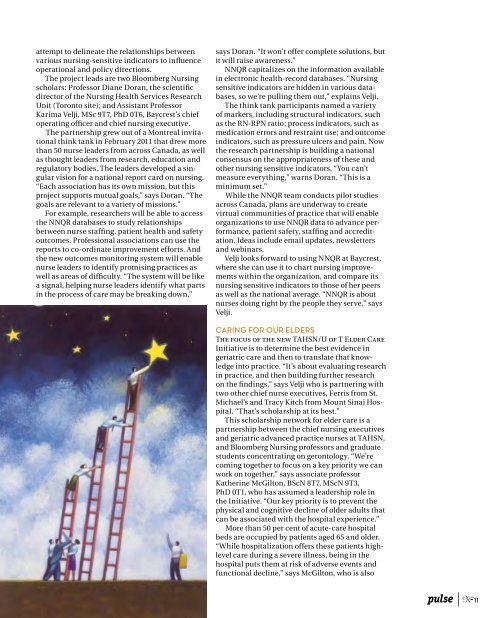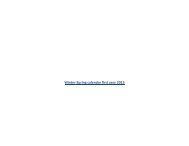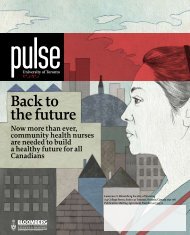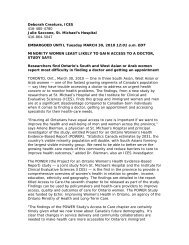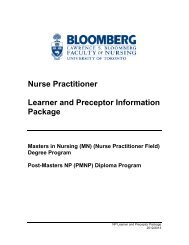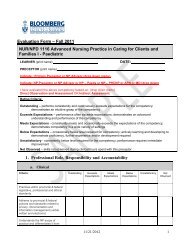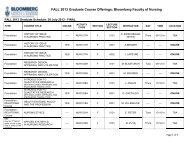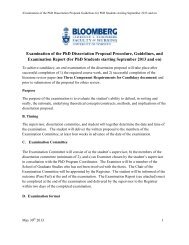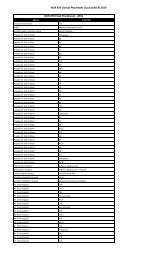Pulse magazine - Lawrence S. Bloomberg Faculty of Nursing
Pulse magazine - Lawrence S. Bloomberg Faculty of Nursing
Pulse magazine - Lawrence S. Bloomberg Faculty of Nursing
- No tags were found...
You also want an ePaper? Increase the reach of your titles
YUMPU automatically turns print PDFs into web optimized ePapers that Google loves.
attempt to delineate the relationships betweenvarious nursing-sensitive indicators to influenceoperational and policy directions.The project leads are two <strong>Bloomberg</strong> <strong>Nursing</strong>scholars: Pr<strong>of</strong>essor Diane Doran, the scientificdirector <strong>of</strong> the <strong>Nursing</strong> Health Services ResearchUnit (Toronto site); and Assistant Pr<strong>of</strong>essorKarima Velji, MSc 9T7, PhD 0T6, Baycrest’s chiefoperating <strong>of</strong>ficer and chief nursing executive.The partnership grew out <strong>of</strong> a Montreal invitationalthink tank in February 2011 that drew morethan 50 nurse leaders from across Canada, as wellas thought leaders from research, education andregulatory bodies. The leaders developed a singularvision for a national report card on nursing.“Each association has its own mission, but thisproject supports mutual goals,” says Doran. “Thegoals are relevant to a variety <strong>of</strong> missions.”For example, researchers will be able to accessthe NNQR databases to study relationshipsbetween nurse staffing, patient health and safetyoutcomes. Pr<strong>of</strong>essional associations can use thereports to co-ordinate improvement efforts. Andthe new outcomes monitoring system will enablenurse leaders to identify promising practices aswell as areas <strong>of</strong> difficulty. “The system will be likea signal, helping nurse leaders identify what partsin the process <strong>of</strong> care may be breaking down,”says Doran. “It won’t <strong>of</strong>fer complete solutions, butit will raise awareness.”NNQR capitalizes on the information availablein electronic health-record databases. “<strong>Nursing</strong>sensitive indicators are hidden in various databases,so we’re pulling them out,” explains Velji.The think tank participants named a variety<strong>of</strong> markers, including structural indicators, suchas the RN-RPN ratio; process indicators, such asmedication errors and restraint use; and outcomeindicators, such as pressure ulcers and pain. Nowthe research partnership is building a nationalconsensus on the appropriateness <strong>of</strong> these andother nursing sensitive indicators. “You can’tmeasure everything,” warns Doran. “This is aminimum set.”While the NNQR team conducts pilot studiesacross Canada, plans are underway to createvirtual communities <strong>of</strong> practice that will enableorganizations to use NNQR data to advance performance,patient safety, staffing and accreditation.Ideas include email updates, newslettersand webinars.Velji looks forward to using NNQR at Baycrest,where she can use it to chart nursing improvementswithin the organization, and compare itsnursing sensitive indicators to those <strong>of</strong> her peersas well as the national average. “NNQR is aboutnurses doing right by the people they serve,” saysVelji.CARING FOR OUR ELDERSThe focus <strong>of</strong> the new TAHSN/U <strong>of</strong> T Elder CareInitiative is to determine the best evidence ingeriatric care and then to translate that knowledgeinto practice. “It’s about evaluating researchin practice, and then building further researchon the findings,” says Velji who is partnering withtwo other chief nurse executives, Ferris from St.Michael’s and Tracy Kitch from Mount Sinai Hospital.“That’s scholarship at its best.”This scholarship network for elder care is apartnership between the chief nursing executivesand geriatric advanced practice nurses at TAHSN,and <strong>Bloomberg</strong> <strong>Nursing</strong> pr<strong>of</strong>essors and graduatestudents concentrating on gerontology. “We’recoming together to focus on a key priority we canwork on together,” says associate pr<strong>of</strong>essorKatherine McGilton, BScN 8T7, MScN 9T3,PhD 0T1, who has assumed a leadership role inthe Initiative. “Our key priority is to prevent thephysical and cognitive decline <strong>of</strong> older adults thatcan be associated with the hospital experience.”More than 50 per cent <strong>of</strong> acute-care hospitalbeds are occupied by patients aged 65 and older.“While hospitalization <strong>of</strong>fers these patients highlevelcare during a severe illness, being in thehospital puts them at risk <strong>of</strong> adverse events andfunctional decline,” says McGilton, who is alsoN o 11


